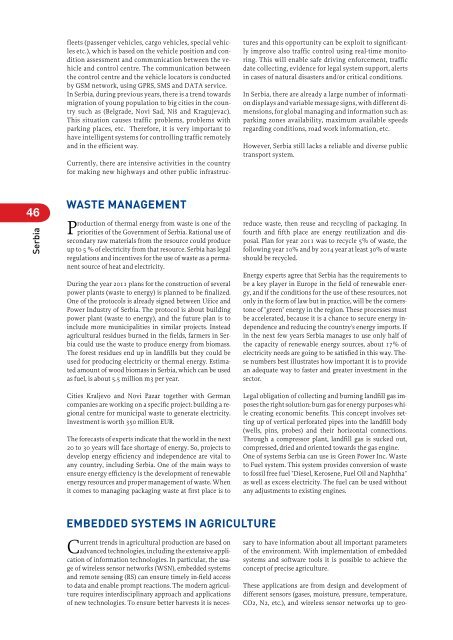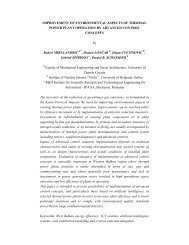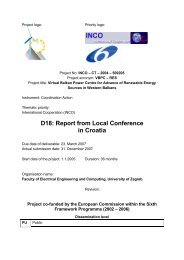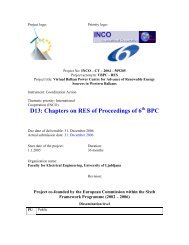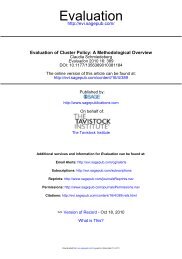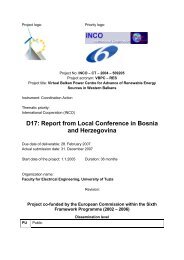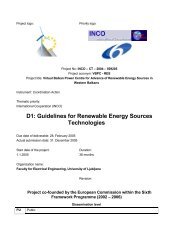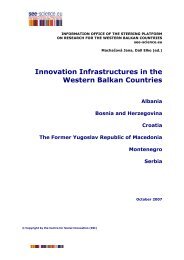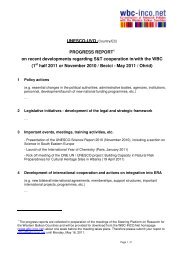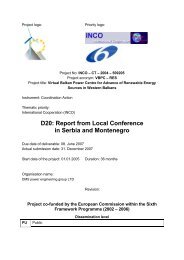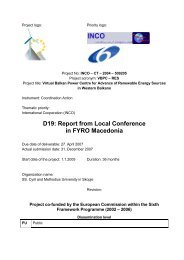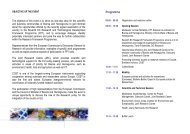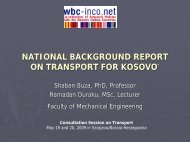National Profile
National Profile
National Profile
Create successful ePaper yourself
Turn your PDF publications into a flip-book with our unique Google optimized e-Paper software.
WASTE MANAgEMENT<br />
ture, forestry, ecology and environmental engineering Instrumented Observational Sites) sites in Europe.<br />
46 47<br />
Serbia<br />
fleets (passenger vehicles, cargo vehicles, special vehicles<br />
etc.), which is based on the vehicle position and condition<br />
assessment and communication between the vehicle<br />
and control centre. The communication between<br />
the control centre and the vehicle locators is conducted<br />
by GSM network, using GPRS, SMS and DATA service.<br />
In Serbia, during previous years, there is a trend towards<br />
migration of young population to big cities in the country<br />
such as (Belgrade, Novi Sad, Niš and Kragujevac).<br />
This situation causes traffic problems, problems with<br />
parking places, etc. Therefore, it is very important to<br />
have intelligent systems for controlling traffic remotely<br />
and in the efficient way.<br />
Currently, there are intensive activities in the country<br />
for making new highways and other public infrastruc-<br />
Production of thermal energy from waste is one of the<br />
priorities of the Government of Serbia. Rational use of<br />
secondary raw materials from the resource could produce<br />
up to 5 % of electricity from that resource. Serbia has legal<br />
regulations and incentives for the use of waste as a permanent<br />
source of heat and electricity.<br />
During the year 2011 plans for the construction of several<br />
power plants (waste to energy) is planned to be finalized.<br />
One of the protocols is already signed between Užice and<br />
Power Industry of Serbia. The protocol is about building<br />
power plant (waste to energy), and the future plan is to<br />
include more municipalities in similar projects. Instead<br />
agricultural residues burned in the fields, farmers in Serbia<br />
could use the waste to produce energy from biomass.<br />
The forest residues end up in landfills but they could be<br />
used for producing electricity or thermal energy. Estimated<br />
amount of wood biomass in Serbia, which can be used<br />
as fuel, is about 5.5 million m3 per year.<br />
Cities Kraljevo and Novi Pazar together with German<br />
companies are working on a specific project: building a regional<br />
centre for municipal waste to generate electricity.<br />
Investment is worth 350 million EUR.<br />
The forecasts of experts indicate that the world in the next<br />
20 to 30 years will face shortage of energy. So, projects to<br />
develop energy efficiency and independence are vital to<br />
any country, including Serbia. One of the main ways to<br />
ensure energy efficiency is the development of renewable<br />
energy resources and proper management of waste. When<br />
it comes to managing packaging waste at first place is to<br />
EMBEDDED SYSTEMS IN AgRIcuLTuRE<br />
Current trends in agricultural production are based on<br />
advanced technologies, including the extensive application<br />
of information technologies. In particular, the usage<br />
of wireless sensor networks (WSN), embedded systems<br />
and remote sensing (RS) can ensure timely in-field access<br />
to data and enable prompt reactions. The modern agriculture<br />
requires interdisciplinary approach and applications<br />
of new technologies. To ensure better harvests it is neces-<br />
tures and this opportunity can be exploit to significantly<br />
improve also traffic control using real-time monitoring.<br />
This will enable safe driving enforcement, traffic<br />
date collecting, evidence for legal system support, alerts<br />
in cases of natural disasters and/or critical conditions.<br />
In Serbia, there are already a large number of information<br />
displays and variable message signs, with different dimensions,<br />
for global managing and information such as:<br />
parking zones availability, maximum available speeds<br />
regarding conditions, road work information, etc.<br />
However, Serbia still lacks a reliable and diverse public<br />
transport system.<br />
reduce waste, then reuse and recycling of packaging. In<br />
fourth and fifth place are energy reutilization and disposal.<br />
Plan for year 2011 was to recycle 5% of waste, the<br />
following year 10% and by 2014 year at least 30% of waste<br />
should be recycled.<br />
Energy experts agree that Serbia has the requirements to<br />
be a key player in Europe in the field of renewable energy,<br />
and if the conditions for the use of these resources, not<br />
only in the form of law but in practice, will be the cornerstone<br />
of "green" energy in the region. These processes must<br />
be accelerated, because it is a chance to secure energy independence<br />
and reducing the country's energy imports. If<br />
in the next few years Serbia manages to use only half of<br />
the capacity of renewable energy sources, about 17% of<br />
electricity needs are going to be satisfied in this way. These<br />
numbers best illustrates how important it is to provide<br />
an adequate way to faster and greater investment in the<br />
sector.<br />
Legal obligation of collecting and burning landfill gas imposes<br />
the right solution: burn gas for energy purposes while<br />
creating economic benefits. This concept involves setting<br />
up of vertical perforated pipes into the landfill body<br />
(wells, pins, probes) and their horizontal connections.<br />
Through a compressor plant, landfill gas is sucked out,<br />
compressed, dried and oriented towards the gas engine.<br />
One of systems Serbia can use is: Green Power Inc. Waste<br />
to Fuel system. This system provides conversion of waste<br />
to fossil free fuel "Diesel, Kerosene, Fuel Oil and Naphtha"<br />
as well as excess electricity. The fuel can be used without<br />
any adjustments to existing engines.<br />
sary to have information about all important parameters<br />
of the environment. With implementation of embedded<br />
systems and software tools it is possible to achieve the<br />
concept of precise agriculture.<br />
These applications are from design and development of<br />
different sensors (gases, moisture, pressure, temperature,<br />
CO2, N2, etc.), and wireless sensor networks up to geo-<br />
referenced databases and geographic information systems<br />
(development information systems capable of efficiently<br />
storing and searching large quantities of data from multimodal<br />
sensors).<br />
Measures can be administered with more precision and<br />
effectiveness, thus providing higher food quality, environmental<br />
protection and considerable savings. In addition,<br />
a better understanding of underlying processes, and validation<br />
and adjustments of the used models can be achieved.<br />
Agriculture is one of the principal sectors in the SEE<br />
region. The Province of Vojvodina is a regional leader in<br />
this sector and the agriculture represents 40% of GDP in<br />
this region.<br />
BioSense Center at the University of Novi Sad is a multidisciplinary<br />
research centre devoted to development and<br />
application of ICT concepts (including embedded systems<br />
and industrial informatics), methods and tools in agricul-<br />
(figure below). The centre is formed to address different<br />
research and technological challenges: from development<br />
of novel sensors for detection and measurement of specific<br />
pollutants, to the integration of measured data into a<br />
unique data base.<br />
Serbia has well-recognized centres like BioSense which<br />
can provide services for acquisition and analysis of data<br />
needed by the large number of different users in the region.<br />
Wide availability of reliable data will foster accelerated<br />
development of contemporary research in ecology,<br />
environmental engineering, forestry and agriculture.<br />
For further development it is important to note that in the<br />
framework of the FP7 project „EXPEER - Distributed Infrastructure<br />
for EXPErimentation in Ecosystem Research“ pilot<br />
site of BioSense center on Fruška Gora (mountain near<br />
Novi Sad) with developed and implemented wireless sensor<br />
networks has been chosen among top 30 HIOS (Highly<br />
Serbia


